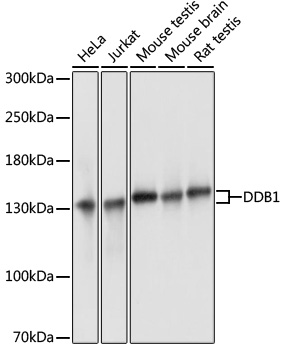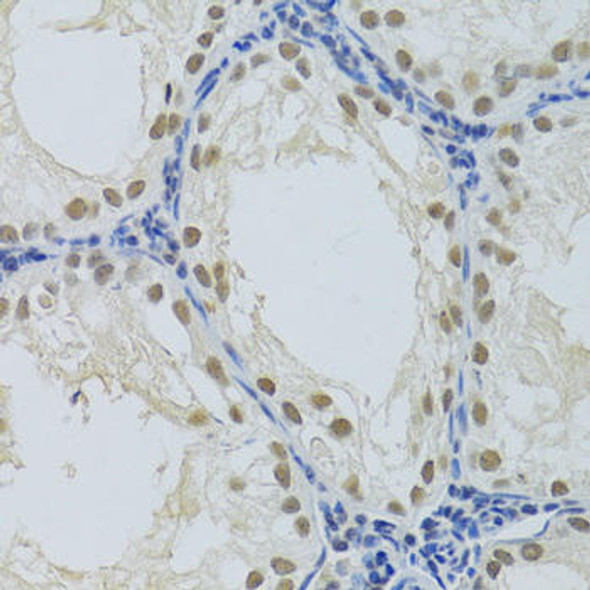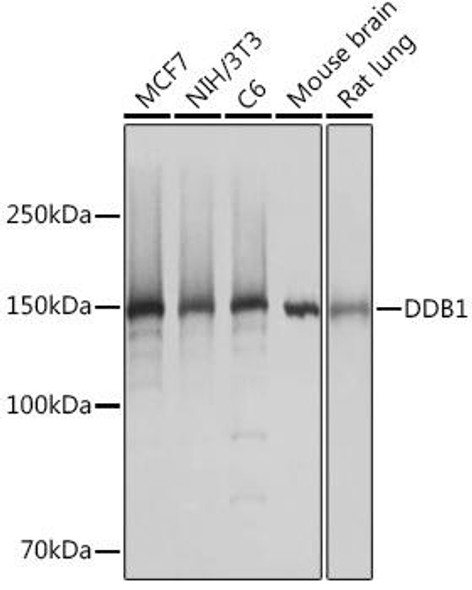Cell Biology Antibodies 9
Anti-DDB1 Antibody (CAB3827)
- SKU:
- CAB3827
- Product Type:
- Antibody
- Reactivity:
- Human
- Reactivity:
- Mouse
- Reactivity:
- Rat
- Host Species:
- Rabbit
- Isotype:
- IgG
- Research Area:
- Cell Biology
Description
| Antibody Name: | Anti-DDB1 Antibody |
| Antibody SKU: | CAB3827 |
| Antibody Size: | 20uL, 50uL, 100uL |
| Application: | WB |
| Reactivity: | Human, Mouse, Rat |
| Host Species: | Rabbit |
| Immunogen: | A synthetic peptide corresponding to a sequence within amino acids 1000 to the C-terminus of human DDB1 (NP_001914.3). |
| Application: | WB |
| Recommended Dilution: | WB 1:500 - 1:2000 |
| Reactivity: | Human, Mouse, Rat |
| Positive Samples: | BT-474, Hep G2, NCI-H460, U-251MG, Jurkat, NIH/3T3, HeLa, Rat testis |
| Immunogen: | A synthetic peptide corresponding to a sequence within amino acids 1000 to the C-terminus of human DDB1 (NP_001914.3). |
| Purification Method: | Affinity purification |
| Storage Buffer: | Store at -20'C. Avoid freeze / thaw cycles. Buffer: PBS with 0.02% sodium azide, 50% glycerol, pH7.3. |
| Isotype: | IgG |
| Sequence: | LGEF VNVF CHGS LVMQ NLGE TSTP TQGS VLFG TVNG MIGL VTSL SESW YNLL LDMQ NRLN KVIK SVGK IEHS FWRS FHTE RKTE PATG FIDG DLIE SFLD ISRP KMQE VVAN LQYD DGSG MKRE ATAD DLIK VVEE LTRI H |
| Gene ID: | 1642 |
| Uniprot: | Q16531 |
| Cellular Location: | Cytoplasm, Nucleus |
| Calculated MW: | 50kDa/126kDa |
| Observed MW: | 127kDa |
| Synonyms: | DDB1, DDBA, UV-DDB1, XAP1, XPCE, XPE, XPE-BF |
| Background: | The protein encoded by this gene is the large subunit (p127) of the heterodimeric DNA damage-binding (DDB) complex while another protein (p48) forms the small subunit. This protein complex functions in nucleotide-excision repair and binds to DNA following UV damage. Defective activity of this complex causes the repair defect in patients with xeroderma pigmentosum complementation group E (XPE) - an autosomal recessive disorder characterized by photosensitivity and early onset of carcinomas. However, it remains for mutation analysis to demonstrate whether the defect in XPE patients is in this gene or the gene encoding the small subunit. In addition, Best vitelliform mascular dystrophy is mapped to the same region as this gene on 11q, but no sequence alternations of this gene are demonstrated in Best disease patients. The protein encoded by this gene also functions as an adaptor molecule for the cullin 4 (CUL4) ubiquitin E3 ligase complex by facilitating the binding of substrates to this complex and the ubiquitination of proteins. |
| UniProt Protein Function: | DDB1: the large subunit of theUV- damaged DNA-binding protein complex (the UV-DDB complex) required for DNA repair. The UV- DDB complex may recognize UV-induced DNA damage and recruit proteins of the nucleotide excision repair pathway (the NER pathway) to initiate DNA repair. The UV-DDB complex preferentially binds to cyclobutane pyrimidine dimers (CPD), 6-4 photoproducts (6-4 PP), apurinic sites and short mismatches. Also appears to function as a component of numerous distinct DCX (DDB1-CUL4-X-box) E3 ubiquitin-protein ligase complexes which mediate the ubiquitination and subsequent proteasomal degradation of target proteins. The functional specificity of the DCX E3 ubiquitin- protein ligase complex is determined by the variable substrate recognition component recruited by DDB1. DCX(DDB2) (also known as DDB1-CUL4-ROC1, CUL4-DDB-ROC1 and CUL4-DDB-RBX1) may ubiquitinate histone H2A, histone H3 and histone H4 at sites of UV-induced DNA damage. The ubiquitination of histones may facilitate their removal from the nucleosome and promote subsequent DNA repair. DCX(DDB2) also ubiquitinates XPC, which may enhance DNA-binding by XPC and promote NER. DCX(DTL) plays a role in PCNA-dependent polyubiquitination of CDT1 and MDM2-dependent ubiquitination of p53 in response to radiation-induced DNA damage and during DNA replication. DCX(ERCC8) (the CSA complex) plays a role in transcription-coupled repair (TCR). May also play a role in ubiquitination of p27kip when associated with CUL4 and SKP2. Component of the UV-DDB complex which includes DDB1 and DDB2. The UV-DDB complex interacts with monoubiquitinated histone H2A and binds to XPC via the DDB2 subunit. Component of numerous DCX (DDB1-CUL4-X-box) E3 ubiquitin-protein ligase complexes which consist of a core of DDB1, CUL4A or CUL4B and RBX1. DDB1 may recruit specific substrate targeting subunits to the DCX complex. These substrate targeting subunits are generally known as DCAF (DDB1- and CUL4-associated factor) or CDW (CUL4-DDB1-associated WD40-repeat) proteins. Interacts with AMBRA1, ATG16L1, BTRC, DCAF1, DCAF17, DCAF16, DCAF15, DDA1, DET1, DTL, ERCC8, FBXW5, FBXW8, GRWD1, DCAF6, KATNB1, NLE1, NUP43, PAFAH1B1, PHIP, PWP1, RBBP4, RBBP5, RBBP7, RFWD2, SNRNP40, VPRBP, WDR5, WDR5B, WDR12, DCAF4, DCAF5, DCAF11, WDR26, DCAF10, WDR39, DCAF12, WDR42, DCAF8, WDR53, WDR59, WDR61, DCAF7, WSB1, WSB2 and WDTC1. DCX complexes may associate with the COP9 signalosome, and this inhibits the E3 ubiquitin-protein ligase activity of the complex. Interacts with NF2, TSC1 and TSC2. Interacts with Simian virus 5 protein V and the HBV X protein. Interaction with SV5 protein V may prevent the recruitment of DCAF proteins to DCX complexes. Interacts with EIF2C1 and EIF2C2. Associates with the E3 ligase complex containing DYRK2, UBR5, DDB1 and VPRBP proteins (EDVP complex). Interacts directly with DYRK2. Belongs to the DDB1 family. |
| UniProt Protein Details: | Protein type:DNA repair, damage Chromosomal Location of Human Ortholog: 11q12-q13 Cellular Component: nucleoplasm; extracellular space; cytoplasm; nucleus Molecular Function:protein binding; DNA binding; damaged DNA binding Biological Process: proteasomal ubiquitin-dependent protein catabolic process; positive regulation of viral genome replication; Wnt receptor signaling pathway; viral reproduction; nucleotide-excision repair; protein ubiquitination during ubiquitin-dependent protein catabolic process; nucleotide-excision repair, DNA damage removal; positive regulation of viral protein levels in host cell; interaction with symbiont; DNA repair; negative regulation of apoptosis |
| NCBI Summary: | The protein encoded by this gene is the large subunit (p127) of the heterodimeric DNA damage-binding (DDB) complex while another protein (p48) forms the small subunit. This protein complex functions in nucleotide-excision repair and binds to DNA following UV damage. Defective activity of this complex causes the repair defect in patients with xeroderma pigmentosum complementation group E (XPE) - an autosomal recessive disorder characterized by photosensitivity and early onset of carcinomas. However, it remains for mutation analysis to demonstrate whether the defect in XPE patients is in this gene or the gene encoding the small subunit. In addition, Best vitelliform mascular dystrophy is mapped to the same region as this gene on 11q, but no sequence alternations of this gene are demonstrated in Best disease patients. The protein encoded by this gene also functions as an adaptor molecule for the cullin 4 (CUL4) ubiquitin E3 ligase complex by facilitating the binding of substrates to this complex and the ubiquitination of proteins. [provided by RefSeq, May 2012] |
| UniProt Code: | Q16531 |
| NCBI GenInfo Identifier: | 12643730 |
| NCBI Gene ID: | 1642 |
| NCBI Accession: | Q16531.1 |
| UniProt Related Accession: | Q16531 |
| Molecular Weight: | 127kDa |
| NCBI Full Name: | DNA damage-binding protein 1 |
| NCBI Synonym Full Names: | damage specific DNA binding protein 1 |
| NCBI Official Symbol: | DDB1 |
| NCBI Official Synonym Symbols: | XPE; DDBA; XAP1; XPCE; XPE-BF; UV-DDB1 |
| NCBI Protein Information: | DNA damage-binding protein 1 |
| UniProt Protein Name: | DNA damage-binding protein 1 |
| UniProt Synonym Protein Names: | DDB p127 subunit; DNA damage-binding protein a; DDBa; Damage-specific DNA-binding protein 1; HBV X-associated protein 1; XAP-1; UV-damaged DNA-binding factor; UV-damaged DNA-binding protein 1; UV-DDB 1; XPE-binding factor; XPE-BF; Xeroderma pigmentosum group E-complementing protein; XPCe |
| Protein Family: | DNA damage-binding protein |
| UniProt Gene Name: | DDB1 |
| UniProt Entry Name: | DDB1_HUMAN |
View AllClose







